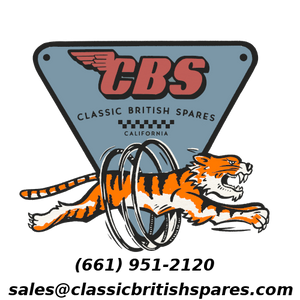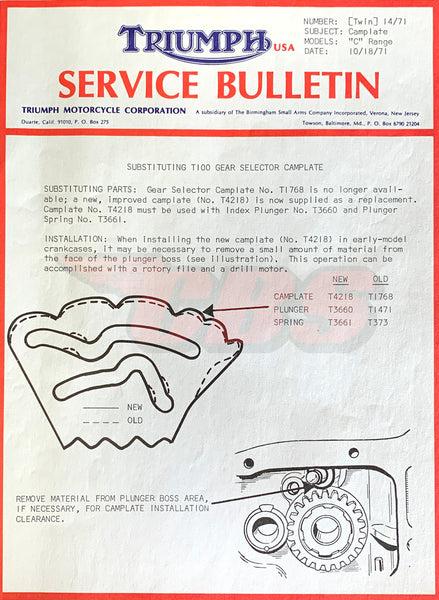
Tech Tip: Triumph T100 Gear Selector Camplates
For today's Tech Tip post we will be covering the two different types of cam plates used (and fitted) to Triumph T100 models from 1959-1974
This also includes the little Triumph 350 twins from 1957-1967..
The camplates (also known as gear selector plates) that we will be covering today come in two variations that happen to be different
Should you be rebuilding a unit 350 or 500 gear box, or perhaps running into "shifting" issues or "popping" out of gear, I recommend that you give this post a thorough read beforing moving forward
Let's dive in
Triumph Service Bulletin
According to a Triumph parts books and an original Triumph Service Bulletin (dated 1971) there appears to be a total of three (3) variations of cam plates made and fitted to all unit 350 / 500 Triumph models from 1959-1974
Although the Service Bulletin above only describes 2 camplates, there where in fact 3 variations used
From history and experience, all 3 plates do work and will offer you satisfactory results, however the later plate is "more refined" with a deeper profile and design as described in the bulletin
Since the later and earlier plates are different, the associated parts that work in conjunction with the plates will be different
Below we will cover both variations of gearbox camplates and also cover the parts that should be used in conjunction with each plate
Camplates
Early 57-1768 / T1768 & 57-1458 / T1458 - 1957-1970

Although the Triumph Service Bulletin does not list the true “early” variation, I will showcase it here for the sake of the post
According to a parts book from 1957-1963, there appears to be a different type of cam plate used and fitted to all 350 and 500 models
Stocked under 57-1458 or T1458
I also noticed that the parts book depicts this particular camplate without a strap but the shift pattern appears to be the same..
In all fairness (and to clear confusion), the 57-1458 plate and the 57-1768 plates are the same, however one has a tie-strap while the other does not
Thickness measures approx .165"
I would suggest using a plate that does have a strap..

When using the came plate 57-1768 or 57-1458 you must use the following parts in conjunction
| Part Type | Part Number | Specifications |
| Plunger | 57-1471 / T1471 | |
| Spring | 57-0373 / 57-373 / T373 | 2 1/2" long |
The camplate plunger as used on early / mid year plates has a very "shallow" point and must be used with the 57-1458 & 57-1471 plates
Late 57-4218 / T4218

The late style of camplate was used from approx 1971 through the end of production (1974) which can be viewed above
This particular plate has a thickness of .170"
Notice the strap..

The parts that were used in conjunction with the late style plate are listed below:
| Part Type | Part Number | Specifications |
| Plunger | 57-3660 / T3660 | |
| Spring | 57-0373 / 57-373 / T373 | 2 1/2" long |
The camplate plunger as used on late shift plates has a "sharp" point and must be used with the 57-4218 / T4218 plates only
Early vs Late

Now that we covered "early and "late" plates above, let's do a side-by-side comparison of both camplates
If you take a closer look, we have pointed out some of the major differences between the two plates; some visual and some intended by design
Notice that the later plate is slightly longer, has deeper grooves and appears to have a refined shift fork pattern as compared to the early plate that has shallow grooves for gear changing and a more “curvy” design
Some early and late plates retained the mandatory strap, however, the early type as shown does not..
The strap is designed to keep the plate "rigid" and to prevent flex; similar to early BSA unit twins
I could only assume Triumph did the "updated" design change to aide with the quality of shiting, gear engagement, and to prevent "popping" out of gear under load..
Installation tips

The Triumph Service Bulletin above states that the later camplate can be used on all models prior, however, when using the later style cam plate (57-4218 / T4218) inside an early motor (pre-1971) you might be forced to remove material around the plunger boss (see photo above) to allow adequate clearance for the later plate
If you take a closer look at the service bulletin above it appears that you can modify your early camplate to “late” specs which consists of carful grinding, polishing and good judgement
With parts being easier to obtain now, I would suggest finding a new or good used later plate and retrofitting to your application
Replacement parts

Should you be working with a worn shifter plate and you happen to be in need of a replacement, finding a “good” used cam plate is going to be tricky
I have seen many used camplates come up on eBay that happen to be worn in the same places
Luckily we do stock new English made replacements camplates for all unit 350 / 500 unit Twins under the “late” specifications
See the chart below for all of our current gear box parts and spares that were discussed above for purchase
| Part Type | Part # | Link |
| Late camplate | 57-4218 / T4218 | Click here |
| Late Plunger | 57-3660 / T3660 | Click here |
| Spring (all years) | 57-0373 / T373 | Click here |
| Early plunger | 57-1471 / T1471 | N/A |
Thanks for reading
Thanks for reading today's Tech Tip post
Click here to view all of our blogs, tech, and news posts
If you have any questions or would like to comment, please use the dedicated fields below
Thanks and ride safe!


Glynn
Great segments, keep em coming.
Bonza, Glynn
Patrick
Thanks for the camplate tech article! Nice job of explaining the “how and why”. The side by side illustration was very helpful. Thanks!
Doug
Don’t over look the shifter mechanism in the outer cover, I dealt with a number of customers who complained of shifter issues on 500s, half the time neglect & wear inside the box,(keep the gear oil healthy! Those rollers and bits need good gear oil) the other 50% were worn springs and the outer bits that transfer to the inner complete, after reading the bulletin we started using later camplates but many modified existing early plates, this sort of feedback from dealers prompted the factory update & bulletin, some shops built test rigs out of scrap cases for different models when diagnosis of gearbox issues, usually cut a big window on the top, I built one after seeing some in racers shops but rarely needed it, most GB problems are obvious
William Edgar
Great info, But what is the cure for the other end of the selector plate getting chewed up by the plungers / Or is the owner using heavy foot ?? Thanks Bill
clark francy
Good information. I’ve been having problems with my ’67 model. This may be of help!